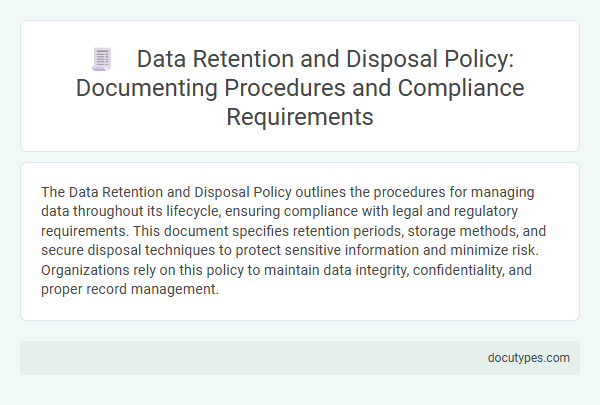The Data Retention and Disposal Policy outlines the procedures for managing data throughout its lifecycle, ensuring compliance with legal and regulatory requirements. This document specifies retention periods, storage methods, and secure disposal techniques to protect sensitive information and minimize risk. Organizations rely on this policy to maintain data integrity, confidentiality, and proper record management.
Introduction to Data Retention and Disposal Policy
| Policy Aspect | Description |
|---|---|
| Document Title | Data Retention and Disposal Policy |
| Purpose | Defines procedures for managing data retention periods and secure disposal methods to protect sensitive information and comply with legal requirements. |
| Scope | Applies to all organizational data, including electronic files, paper records, and backup media, across departments and locations. |
| Introduction | This policy guides how your organization retains and disposes of data to ensure information security, regulatory compliance, and risk mitigation throughout the data lifecycle. |
| Key Procedures | Specifies retention schedules based on data categories, methods for secure disposal such as shredding or secure deletion, and roles responsible for compliance monitoring. |
| Legal Compliance | Aligns with data protection laws, industry standards, and contractual obligations to avoid penalties and safeguard stakeholder trust. |
Purpose and Scope of the Policy
The Data Retention and Disposal Policy outlines the specific procedures for securely managing data throughout its lifecycle. Its purpose is to ensure compliance with legal, regulatory, and organizational requirements while protecting sensitive information from unauthorized access. The policy applies to all employees, contractors, and systems handling data within the organization.
Definitions and Key Terminologies
This policy document outlines the procedures for data retention and disposal, ensuring compliance with legal and organizational standards. It defines essential terms to clarify responsibilities and processes for managing data throughout its lifecycle.
Understanding key terminologies is crucial for properly handling your data according to this policy.
- Data Retention - The period during which data must be preserved and maintained before authorized disposal.
- Data Disposal - The process of securely destroying data after the retention period expires to prevent unauthorized access.
- Confidential Information - Sensitive data that requires protection under this policy to maintain privacy and security.
Regulatory and Compliance Requirements
The Data Retention and Disposal Policy outlines the specific procedures your organization must follow to securely retain and dispose of data. It ensures compliance with regulatory requirements such as GDPR, HIPAA, and industry-specific standards. Adhering to these guidelines helps protect sensitive information and minimize legal risks related to data management.
Data Classification and Retention Categories
The Data Retention and Disposal Policy outlines the procedures for managing data throughout its lifecycle. This document categorizes data based on its classification to ensure appropriate handling and protection.
Data classification divides information into levels such as confidential, internal, and public, determining retention and disposal requirements. Retention categories specify timeframes for data storage based on legal, regulatory, and business needs. Proper adherence to these procedures ensures compliance and reduces risk associated with data mishandling.
Documented Procedures for Data Retention
What document details procedures for data retention and disposal? Documented procedures for data retention are typically outlined in a Data Retention Policy or Records Management Policy. This document specifies how data is stored, retained, and securely disposed of to comply with legal and regulatory requirements for your organization.
Secure Data Disposal Processes
The Data Retention and Disposal Policy outlines the procedures for managing data throughout its lifecycle, emphasizing secure data disposal processes. Proper disposal methods prevent unauthorized access and ensure compliance with regulatory requirements.
- Retention Schedule - Specifies the duration for which different types of data must be retained before disposal.
- Disposal Methods - Describes approved techniques such as shredding, degaussing, or secure deletion for data destruction.
- Verification and Documentation - Requires confirmation that disposal actions are completed and records maintained for audit purposes.
Strict adherence to these procedures safeguards sensitive information and mitigates risks associated with data breaches.
Roles and Responsibilities in Policy Enforcement
The Data Retention and Disposal Policy document outlines the procedures for managing data throughout its lifecycle. It emphasizes clear roles and responsibilities in enforcing these policies to ensure compliance and security.
- Policy Owner - Oversees the development, implementation, and review of data retention and disposal procedures.
- Department Managers - Ensure team adherence to the retention schedules and proper data disposal practices.
- Employees - Follow defined guidelines to securely handle, retain, and dispose of data as per policy requirements.
Monitoring, Auditing, and Compliance Reporting
The Data Retention and Disposal Policy outlines the procedures for securely managing data throughout its lifecycle, emphasizing clear guidelines for retention periods and secure disposal methods. It ensures that data handling aligns with legal and organizational requirements to protect sensitive information.
Monitoring within the policy involves regular checks to verify adherence to retention schedules and disposal processes. Auditing procedures provide systematic reviews, while compliance reporting tracks and documents any deviations or improvements needed.
What Document Details Procedures for Data Retention and Disposal? Infographic

